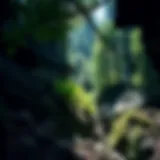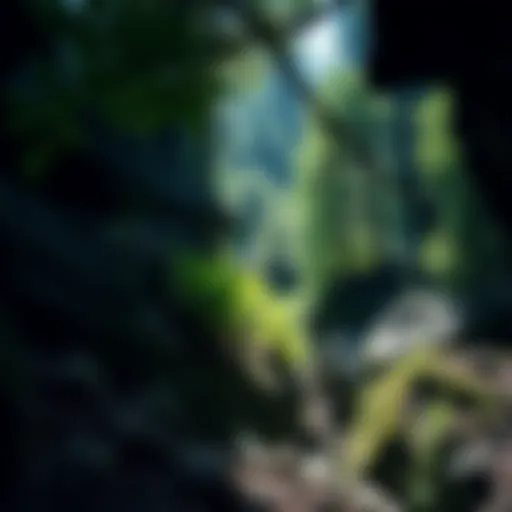Russian River Fishing: Techniques, Species, and Ecology
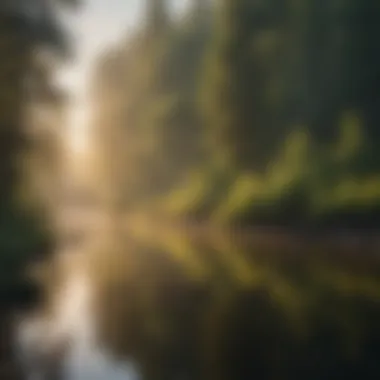

Intro
Fishing is more than just a pastime; it’s a gateway into the interconnectedness of nature. Particularly in places like the Russian River, it serves as a reflection of the health of the environment and the delicate balance we must strive to maintain. This guide will help you appreciate the fishing opportunities here, while also recognizing the broader ecological significance of the woods and waters that sustain fishermen and the wildlife they seek.
The Russian River, winding through Northern California, is home to a rich tapestry of flora and fauna. The river's waters not only support various fish species but are also vital to the local ecosystem. Anglers, whether veterans or fresh to the sport, will find both challenges and rewards in this pristine environment.
As we dive into the details, we’ll explore the woodland ecosystems surrounding the river, including their biodiversity and the role these forests play in our climate. We’ll also take a closer look at sustainable practices that can help ensure the vitality of this stunning locale for generations to come. With a keen focus on community engagement, it becomes imperative for all of us to understand and embrace our role as stewards of this magnificent resource.
Understanding Woodland Ecosystems
Importance of Biodiversity in Forests
Biodiversity is the lifeblood of the forested areas surrounding the Russian River. Rich populations of various species contribute to creating a balanced ecosystem, enabling the natural checks and balances essential for long-term health. In these woodlands, one can find a multitude of plant species that provide food and habitat for a variety of animals. For example, oak trees offer acorns that nourish deer, while the undergrowth supports smaller mammals and numerous insects.
Role of Forests in Climate Regulation
Forests act as carbon sinks, absorbing carbon dioxide from the atmosphere and helping to mitigate climate change. Specific tree species in the Russian River area, like the redwoods, can store significant amounts of carbon over their lifetimes, greatly impacting local air quality. Moreover, woodlands enhance soil quality through organic matter decomposition, which directly influences water filtration and availability in the riverbanks.
“The health of our forests is directly tied to the well-being of our fishing waters,” remarked a local ecologist engaged in watershed studies. This relationship underscores the importance of preserving these forested areas.
Sustainable Forestry Practices
Principles of Sustainable Forestry
Sustainable forestry is crucial for maintaining the beauty and ecological balance of the Russian River region. Practices such as selective logging, maintaining habitat corridors, and reducing chemical use play significant roles in this concept. Here, the idea is not just to take from nature, but to do so in a way that allows the ecosystem to regenerate and thrive.
Case Studies of Successful Implementations
Analyzing successful sustainable forestry methods reveals a pattern of community involvement and ecological mindfulness. For instance, the Sonoma County Forest Conservation Program emphasizes education and legal mandates that protect forest habitats while allowing responsible use. Similarly, partnerships with local indigenous tribes ensure that traditional ecological knowledge informs modern sustainable practices, leading to better forest health and resilience.
Woodland Stewardship Techniques
Forest Management Plans
Implementing effective forest management plans is paramount for the realms surrounding the Russian River. These plans typically include provisions for monitoring the health of the forest, conducting wildlife assessments, and determining the best practices for timber harvesting. They also encourage public participation and awareness, fostering a sense of responsibility and pride among local residents.
Conservation Strategies
Conservation strategies not only focus on preserving the existing forests but also aim to restore damaged ecosystems. This can involve reforestation efforts, invasive species management, and habitat restoration projects that are all crucial components for sustaining the river's fishing environment. Engaging local communities ensures these strategies are effective and rooted in the needs and values of the people who live there.
As we continue to explore the fishing opportunities in the Russian River, let’s keep in mind that each catch and release reflects a deeper commitment to the ecosystem and an understanding of its intricate balance.
Overview of the Russian River Ecosystem
The Russian River holds a unique spot not only in California's natural landscape but also in its intricate environmental tapestry. This section serves as a primer on the river's ecosystem, shedding light on the geographical and ecological aspects that define it. Understanding these elements is key for seasoned anglers and novices alike, as they influence fish behavior, conservation efforts, and the overall fishing experience.
Geographical and Ecological Context
The Russian River meanders through the heart of Sonoma County and extends into Mendocino County, offering a diverse range of habitats. Spanning approximately 110 miles, the river's journey from the coastal hills down to the Pacific creates a patchwork environment characterized by riparian zones, wetlands, and estuarine systems. Each of these regions supports diverse flora and fauna.
The river's headwaters emerge from the fog-kissed hills of the Mayacamas Mountains, where rainfall nurtures lush vegetation. As it flows south, it transitions through sandy banks, gravel bars, and densely wooded areas. This geographical variation not only enriches the aesthetic but also provides essential habitats for various species, including critical spawning grounds for salmon and steelhead.
The river's ecosystem is dynamic and interconnected, emphasizing the importance of mindful engagement with this natural resource.
Understanding these geographical features is paramount for anglers. Knowing where fish are likely to nest or hunt can drastically enhance the chances of a successful outing. For instance, quieter eddies or shaded bends often signal prime locations for spotting fish, particularly during summer months when they seek cooler water.
Importance of the River to Local Biodiversity
The ecological significance of the Russian River extends beyond mere fishing opportunities. It functions as a vital artery for local biodiversity, supporting a plethora of species. Essential fish populations, including native coho and chinook salmon, rely on the river for spawning. Their lifecycle, which involves both upstream migration to spawn and downstream travel to the ocean, showcases the river’s critical role in sustaining fish populations.
Moreover, the river supports various wildlife species, such as otters, herons, and numerous bird species. The intertwining of aquatic and terrestrial life forms a robust ecosystem that contributes to the regional biodiversity.
Diverse plant communities at the riverbank also play a role. Willows, cottonwoods, and sycamores form a protective canopy, which in turn, stabilizes riverbanks and provides essential nutrients to the waterway. The symbiotic relationships within this ecosystem underscore the importance of preserving the river's health.
For both residents and visitors, understanding these interdependencies offers a deeper appreciation of the Russian River. The health of local wildlife populations frequently reflects the river's overall condition, making every fishing trip not only a chance to catch but also an opportunity to witness and reaffirm our role as stewards of the environment.
In sum, the Russian River encompasses a diverse habitat framework that is integral to both its fish populations and broader ecological health. For anglers, an astute knowledge of this ecosystem is invaluable—serving as a foundation for responsible fishing practices and engaging with nature's intricacies.
Fish Species in the Russian River
The rich tapestry of fish species inhabiting the Russian River not only represents a significant aspect of its ecosystem but also plays a crucial role in the fishing culture of the region. Understanding the types of fish present can be instrumental for anglers attempting to navigate the waters effectively. This section delves into the native species that call the river home, as well as those non-native species that pose challenges to the local ecosystem.
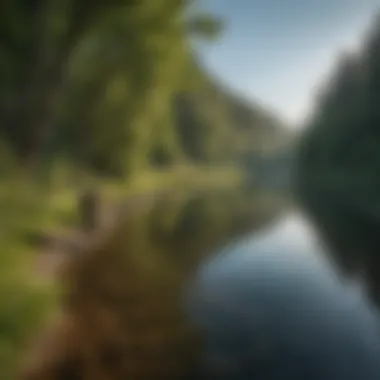

Native Species Overview
Native fish species in the Russian River contribute significantly to the river's ecological balance and cultural heritage. Some of the prominent natives include the Coho salmon and steelhead trout, both of which have historical significance and support a vibrant fishing community.
- Coho Salmon: This species is particularly sought after for its fighting spirit and flavor. They typically travel upstream to spawn during the fall, making late autumn an ideal time for anglers. Understanding their spawning cycles is vital, as it dictates their migratory patterns.
- Steelhead Trout: Renowned for their acrobatic behavior when hooked, steelhead are a gem for anglers. Their lifecycle includes both freshwater and ocean phases, making them a unique addition to the river’s biodiversity. They can be found in the river year-round, with peak fishing seasons coinciding with their spawning times.
- Other Noteworthy Natives: Species like Pacific lamprey and various species of dace also populate the river.
Native species not only provide recreational opportunities but also support local food webs, impacting everything from insect populations to bird species that rely on fish for sustenance. By protecting these species, the local community can ensure that future generations will continue to enjoy river fishing.
Invasive Fish Species
Invasive fish species are a significant concern for the Russian River, disrupting the native ecosystem and impacting fishing practices. These species often outcompete native fish for resources, leading to declines in native populations.
- Northern Pike: Known for their aggressive nature, northern pike can quickly dominate water bodies upon introduction. Their presence in the Russian River contributes to the decline of native species, prompting local biologists to implement control measures.
- Catfish: While they may be enjoyed by some anglers, catfish can hinder the natural reproduction of native species by preying on their eggs and juvenile fish.
- Other Invasive Species: Species such as the American bullfrog have also been noted, which indirectly affect fish populations by predating on their young.
To combat these invasive invaders, it is essential for anglers to adhere to regulations and report sightings of non-native species. Engaging in responsible fishing practices not only helps protect the native biodiversity but also secures the longevity of fishing opportunities in this unique habitat.
"Preserving the native fish species is like safeguarding the river's voice; without it, the local ecosystems lose their rhythm."
Fostering awareness about the native and invasive species in the Russian River is crucial for conservation efforts and helps ensure a balanced and thriving fishing environment. Understanding these dynamics will enable anglers to engage in sustainable fishing practices, benefiting the river and its community in the long run.
Best Fishing Techniques for the Russian River
When venturing into the Russian River for fishing, the techniques you choose can make all the difference. Each method has its own set of advantages and caters to different fishing styles, environmental conditions, and personal preferences. Understanding the best fishing techniques for this river is crucial not just for a fruitful day out but also to enhance your appreciation of the surrounding ecosystem. Here, we explore various approaches, dictating how and when to apply them, while keeping in mind the unique traits of the fish and their habitats.
Fly Fishing Approaches
Fly fishing in the Russian River is a nuanced experience that requires both skill and an understanding of the river's unique currents and food sources. This technique is exemplified by its use of artificial flies that mimic the natural prey fish consume. Some fish species are more susceptible to these flies during certain times of the day, especially during dawn and dusk, when they are actively feeding.
- To master fly fishing here, one of the key recommendations is to develop a feel for the water’s rhythm. Utilizing a 5 or 6-weight rod paired with floating lines is often effective. This setup allows anglers to cast in various locations along the riverbank, targeting pools and riffles that hold fish.
- Matching the fly to the hatch, or the type of insects emerging in the water, can drastically improve success rates. For example, using dry flies like the Elk Hair Caddis during the late spring can entice hungry trout.
- Additionally, the importance of stealth cannot be overstated in this technique. Fish can be easily spooked, so practicing quiet casting and slow movements is vital.
Spin Fishing Tactics
Spin fishing is another popular method among anglers in the Russian River. It’s often seen as more approachable for beginners who are just getting their feet wet. This technique’s versatility allows you to target a wide range of species, from steelhead to bass, within various water conditions.
- Utilizing light spinning gear—often with a 6-pound test line—provides an advantage when dealing with the river's diverse species. Spinners and jigs work exceptionally well, particularly during active feeding times. Depending on the time of year, you might find that silver spinners are particularly effective in attracting fish.
- It’s essential to focus on temperature and water levels, for these can significantly affect fish behavior. For instance, deeper holes tend to harbor fish during warmer months. Casting close to structures, like fallen trees or rocky outcrops, where fish tend to hide, can also lead to successful strikes.
- Another consideration is the retrieval technique. Varying the speed and action of your bait can provoke strikes even from indifferent fish. A slow retrieve, interspersed with sudden jerks or pauses, often mimics the movements of distressed prey.
Bait Selection and Presentation
Bait selection is a foundational part of any angler's strategy when fishing in the Russian River. The choice of bait can often be as defining as the technique employed. Anglers must consider not only the target species but also seasonal availability of natural food sources.
- Natural baits, like nightcrawlers or salmon eggs, can be particularly effective. Using a slip sinker rig allows precise bait placement at varying depths, crucial during different seasons.
- Understanding the water's characteristics is equally significant. During high flows, larger baits such as herring can be deployed to enhance visibility and attract fish from afar. Conversely, lighter, smaller baits may work better in shallower, clear waters where fish might be more cautious.
- Presentation also matters. The way bait is presented can either entice a fish to bite or send it running for cover. A slow, natural drift downstream often mimics the way food is carried in current, making it more appealing to waiting fish.
"Fishing is a sport of observation; your connection to the water can influence your success rate significantly."
Overall, understanding these methods equips anglers with the knowledge to enhance their fishing experience on the Russian River. Each technique offers valuable lessons on patience, adaptability, and respect for the river's ecosystem. Fishing here isn’t just about the catch but also about fostering a lifelong appreciation for its natural beauty.
Seasonal Patterns in Fishing
Understanding the seasonal patterns of fishing in the Russian River is crucial for both seasoned anglers and newcomers. Each season brings with it a unique set of challenges and opportunities that dictate fish behavior, feeding patterns, and the overall fishing experience. Recognizing these patterns allows anglers to adapt their strategies, ultimately enhancing their chances of a successful catch. By delving into the nuances of each season, we make informed decisions that align with the natural rhythms of the river. This part of the guide sheds light on spring opportunities, summer peaks, autumn behavior adjustments, and winter challenges, equipping anglers with the knowledge necessary to outsmart their aquatic targets.
Spring: Opportunities and Strategies
As winter melts away, the Russian River awakens in spring, unveiling new fishing opportunities. The water begins to warm, often leading to an increase in fish activity. Native species, like steelhead trout and salmon, return to spawn, making this a prime time for anglers. During this period, fish can be found in the shallow waters, as they become more aggressive and responsive to bait.
Here are some strategies to consider for spring fishing:
- Focus on the Inflows: Spring runoff from melting snow increases flow; therefore, fish are often drawn to inflows where they can find food.
- Use Bright Colors: In murky waters, using bright-colored lures can attract attention.
- Adjust Techniques: Try drifting bait or using floats to keep your bait at the right depth, elevating your chances of a bite.
By utilizing these tactics, anglers can find success as the river transitions from the cold grip of winter.
Summer: Peak Fishing Periods
As summer settles in, the Russian River transforms into a bustling playground for fish and anglers alike. Warm temperatures lead to a peak in fishing activity. Species such as rainbow trout flourish, and many anglers flock to the river, often making this the busiest fishing season.
Summer fishing has its nuances:
- Early Morning or Late Evening: Fish are more likely to feed in the cooler parts of the day, so early risers or those patient enough to wait for dusk will benefit.
- Target Deeper Pools: During the hotter days, fish may seek deeper, cooler waters. Look for shaded spots or deeper pools in the river where fish might hang out.
- Match the Hatch: Pay attention to the insects present in the area and select lures or flies that mimic these to trigger strikes.
Understanding the dynamics of summer fishing can lead to abundant catches and memorable fishing trips.
Autumn: Changes in Fish Behavior
With the arrival of autumn, changes in fish behavior become evident as water temperatures begin to drop. Fish sense the approaching winter, leading to a final feeding frenzy before the colder months set in. This is when you will notice the fish becoming more active in preparation for spawning, especially species like salmon and steelhead.
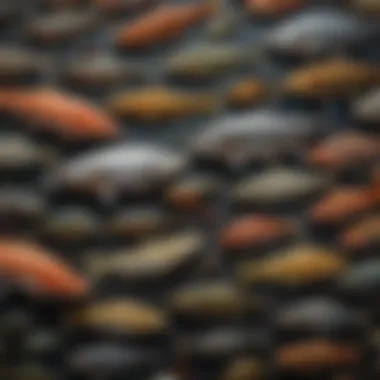

Key points to consider during autumn include:
- Increased Aggressiveness: Fish often become aggressive as they feed heavily to prepare for winter, making this a fruitful time for anglers.
- Plan for Fluctuating Weather: Autumn weather can be unpredictable, so keep a close eye on forecasts and adapt accordingly.
- Focus on Spawning Grounds: During this season, finding and fishing near spawning grounds can result in a fruitful experience as fish congregate in these areas.
The fall season, with its vibrant colors and feeding frenzy, creates a distinctive backdrop for anglers seeking to maximize their experience.
Winter: Challenges and Opportunities
Winter fishing in the Russian River is a different ball game, often marked by cold temperatures and low fish activity. However, it also presents unique opportunities for the intrepid angler willing to brave the cold. Fish tend to become less active, hiding in deeper waters and requiring patience and precise technique.
Here are some considerations for winter fishing:
- Use Scented Baits: As fish feed less frequently, using scented baits can entice them to bite.
- Join a Winter Fishing Group: Connecting with local anglers through forums and social media can provide insights about what’s working during the colder months. Check out platforms like Reddit or local fishing clubs on Facebook.
- Adapt to Conditions: Be prepared to adjust your approach based on cold temperatures and possible ice conditions, looking for open water where fish might still be active.
Winter fishing brings its own set of obstacles, but for those who adjust their tactics and expectations, it can provide rewarding experiences.
Regulations and Conservation Efforts
Understanding the regulations and conservation efforts surrounding fishing in the Russian River is crucial. These guidelines not only protect fish populations but also ensure that the ecosystem remains balanced for future generations. Compliance with fishing regulations serves as a foundational aspect of responsible angling, promoting sustainable practices among the fishing community.
Notably, these regulations help to manage fish stocks, restrict harmful practices, and set seasons for fishing that correspond to ecological cycles. They are tailored to safeguard both fish species and their habitats from overfishing and environmental degradation. Consequently, anglers must remain vigilant about these guidelines to contribute positively to the river’s health and sustainability.
State Fishing Regulations
State fishing regulations in the Russian River encompass a wide array of rules aimed at protecting local fish populations and their habitats. Often, these rules vary depending on the specific species targeted and the type of fishing method employed. For instance, certain fish such as the steelhead trout have specific seasons during which they can be harvested, along with size and bag limits that must be adhered to.
In addition to species-specific regulations, anglers should also familiarize themselves with the following points:
- Licensing Requirements: A valid fishing license is mandatory for anyone over a specific age. This ensures that fishing activities are monitored and regulated.
- Fishing Gear Restrictions: Certain areas may impose restrictions on fishing gear types. For example, the use of live bait may be discouraged in certain sections of the river to prevent ecosystem disruption.
- Seasonal Closures: To allow fish populations to reproduce, periods might exist where fishing is completely prohibited.
- Catch and Release Programs: Many anglers are encouraged to practice catch-and-release methods, particularly for endangered or vulnerable species.
Staying informed about these regulations can enhance the fishing experience while also ensuring that the delicate balance of the ecosystem remains intact. Neglecting these laws can lead to significant consequences, not only for the fish but for the angler’s future fishing opportunities.
Conservation Groups and Initiatives
A host of conservation groups and initiatives operate along the Russian River, aiming to protect the aquatic environment and the biodiversity it sustains. These organizations operate on multiple fronts, coordinating efforts that range from habitat restoration to public education about sustainable fishing practices.
Some key roles played by these groups include:
- Habitat Restoration: Many initiatives focus on restoring degraded habitats, such as removing invasive species and replanting native vegetation along riverbanks. This is vital for maintaining natural habitats conducive to fish spawning and growth.
- Public Awareness Campaigns: Education is at the heart of many conservation organizations' efforts. They often organize community events to share knowledge on sustainable practices and the importance of preserving the river's ecosystem.
- Research and Monitoring: Teams of scientists and volunteers constantly study fish populations and environmental health. This research helps inform regulations and improve conservation efforts.
- Community Involvement: Many groups encourage local anglers to participate in conservation activities, fostering a sense of responsibility towards the river's health.
These groups standardly engage with the community, making it crucial for anglers and stakeholders to support their endeavors. Through collaborative efforts, the vision of a thriving, sustainable fishing environment in the Russian River can be realized.
Ethics of Fishing in the Russian River
Fishing in the Russian River isn't just about the catch; it's also about maintaining an ecological balance. As anglers, we should always carry the weight of our actions, acknowledging that every line cast can have a ripple effect on the ecosystem. Embracing ethical fishing practices ensures not only the sustainability of fish populations but also the health of surrounding wildlife and habitats. This section will explore two critical aspects: sustainable fishing practices and respecting wildlife and habitats.
Sustainable Fishing Practices
Sustainable fishing is grounded in recognizing our role within the environment. It's essential to apply strategies that promote long-term viability of fish species while safeguarding their habitats. Here are a few measures that can help achieve sustainable fishing in the Russian River:
- Catch and Release: Keeping only what you can use can help maintain the fish population. Release the others carefully, minimizing their stress.
- Proper Gear: Using barbless hooks or circle hooks can significantly reduce injury to fish when caught and released.
- Seasonal Awareness: Fishing during designated seasons helps avoid overfishing during spawning times.
- Be Mindful of Invasive Species: Educate yourself on species like the Largemouth Bass and Striped Bass, which can disrupt the local ecosystem. Avoid introducing non-native species to the river.
These practices not only protect the aquatic life but also enhance the overall fishing experience. As one angler put it,
"When you respect the river, the river respects you back."
By prioritizing sustainability, anglers contribute to preserving the rich biodiversity of the Russian River, ensuring future generations can enjoy its splendor.
Respecting Wildlife and Habitats
The Russian River is home to various wildlife, including birds, mammals, and other aquatic species. It’s imperative that we respect these creatures and their habitats while fishing. Anglers can embrace these principles:
- Stay on Designated Paths: Avoid trampling soil or vegetation along the banks. Follow established trails and access points to minimize habitat disruption.
- Keep Noise Levels Down: Many species, especially nesting birds and wildlife on shorelines, are sensitive to noise. Keep your activities as quiet as a whisper when fishing.
- Do Not Disturb Nests: If you encounter nests or breeding areas, maintain a respectful distance and avoid causing stress to the animals.
- Waste Management: Always clean up after yourself. Dispose of trash properly and avoid leaving any fishing line, bait containers, or other debris behind.
Through respecting wildlife and their homes, we honor an age-old relationship with nature, fostering a delicate balance that is beneficial for all involved. It’s all about being good stewards of the rivers we cherish.
In summary, the ethics of fishing go beyond catch limits and regulations. They encapsulate a philosophy rooted in sustainability and respect for nature. Embracing these ethics can transform a fishing trip into a profound connection with the environment.
Community Engagement and Education
Community engagement and education play a vital role in the sustainability and stewardship of the Russian River's fishing environment. Both elements enhance the overall experience for anglers while fostering a sense of responsibility towards the river's ecosystem. By building connections between individuals and the natural world, these initiatives help ensure the river remains a vibrant source of life while promoting conscientious fishing practices.
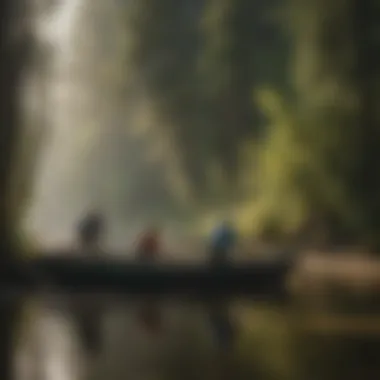

The local community has a significant impact on the health of the river. When anglers come together to share knowledge and resources, they develop a deeper understanding of the environmental factors that affect fish populations and habitats. This understanding is crucial not only for preserving the biodiversity of the river but also for enriching the fishing experience itself.
"Education creates proactive anglers who are more likely to adopt sustainable fishing practices and share their knowledge with others."
Individuals who engage in activities focused on community and education can better grapple with the complexities of fishing regulations, ecological concerns, and emerging fish species trends. Overall, this engagement nurtures a culture of responsibility and conservation—cultivating a society that respects the delicate balance of the ecosystem while maximizing the joys of fishing.
Local Fishing Clubs and Organizations
Local fishing clubs and organizations serve as cornerstones of community engagement within the Russian River area. By fostering a sense of camaraderie among anglers, these groups work towards common goals like habitat restoration, education, and promoting sustainable practices. Many clubs also advocate for equitable access to fishing resources, ensuring that all community members can enjoy the river’s bounty.
Moreover, clubs often provide valuable resources, such as:
- Mentorship opportunities for novice fishers, helping them improve their skills and knowledge.
- Access to exclusive fishing spots that might not be available to the general public.
- Regular meetings and social events, allowing members to network and exchange tips and experiences.
These collective efforts not only enhance the individual experience but also promote a strong conservation ethic. By joining a local fishing club, individuals become part of a broader movement aimed at maintaining the health of the river while having fun doing what they love.
Workshops and Educational Events
Workshops and educational events offer an appealing avenue for community engagement in the context of fishing in the Russian River. These gatherings emphasize the importance of knowledge-sharing and skill development, making fishing a more informed and enjoyable endeavor for everyone involved. Often organized by local clubs, conservation groups, or educational institutions, these events can cover a variety of topics.
Some popular themes include:
- Introduction to sustainable fishing techniques: This segment often focuses on practices that minimize environmental impact while optimizing the fishing experience.
- Understanding the river's ecology: Gaining insight into local species, their habitats, and seasonal behaviors can significantly enhance an angler's proficiency.
- Regulations and conservation policies: Keeping anglers informed about current laws and conservation initiatives is crucial for responsible fishing.
These educational efforts often culminate in hands-on experiences, such as guided fishing trips or field studies, allowing participants to apply their newly acquired knowledge directly in the river environment. By fostering a culture of learning, these workshops empower local fishers to not only improve their skills but also contribute positively to the health of the Russian River ecosystem.
Personal Experiences and Anecdotes
Engaging with personal stories significantly enriches the narrative around fishing in the Russian River. These anecdotes breathe life into the statistics and techniques discussed in other sections, transforming abstract knowledge into relatable experiences. It creates a thread of community connection among anglers, embodying the spirit of camaraderie that fishing fosters.
When local anglers share their experiences, they not only contribute distinct insights into the nuances of the river but also highlight the common struggles, triumphs, and exquisite moments that define fishing in this area. Each tale has the power to inspire both newer and seasoned anglers looking for nuances they hadn’t considered.
By weaving these stories into the broader narrative, this article aims to present fishing not merely as a pastime but as a rich tapestry of relationships, both with the river and fellow enthusiasts.
Stories from Local Anglers
Local anglers possess a reservoir of knowledge, honed through years of casting lines into the waters of Russian River. Jenny, a lifelong resident of the area, often recalls her first fishing trip as a child. "I remember sitting on the bank with my granddad, who was so patient, teaching me how to bait the hook. The joy of reeling in my first trout was unforgettable!" Such stories not only showcase personal milestones but also indicate the profound legacy of fishing passed down through generations.
Additionally, fishermen like Mark, who spends his weekends at different spots along the river, bring forward practical insights. He once mentioned, "You’ve got to know the spots where the fish hide; it’s not just about luck but understanding the river’s mood." His experience speaks to the importance of local knowledge and understanding the shifting behaviors of different species.
These narratives provide newer anglers with valuable tips that may not be found in books. Every fisherman has their techniques, learned through subtle observations and sometimes, a bit of trial and error, which contribute to a deeper understanding of fishing in the Russian River's unique environment.
Memorable Fishing Adventures
Every fishing trip holds the potential for adventure, and the Russian River has seen more than its fair share. Take, for instance, the year a group of friends embarked on an extended fishing trip along the river. After setting up camp, they fished at dawn. Aaron, one of the participants, recalls the moment: "The sun was just rising, casting a golden hue over the water, and I hooked the biggest salmon I had ever seen! The struggle felt endless, but when I finally landed it, I was ecstatic!"
These moments are etched in memory, showcasing not simply the thrill of catching fish, but the emotional highs and lows that come with fishing. They speak to the connection forged not only with the river but also with friends and family, creating lasting bonds through shared challenges and victories.
Moreover, such experiences often serve as catalysts that deepen appreciation for nature. As anglers traverse different stretches of the river, they witness its changing face through seasons, weather, and even their own growth as fishermen. Each trip, whether successful or not, leaves an imprint that complements the ongoing relationship to outdoor life.
"It’s the stories, not the fish, that keep us coming back to the river."
— Local Angler
Culmination: The Future of Fishing in the Russian River
As we look to the future of fishing in the Russian River, it is essential to contemplate not only the enjoyment that quests for fish provide but also the sustainability that underpins this cherished activity. The river, with its dynamic ecosystem, serves as a reminder of the delicate balance between human interaction and natural habitats. Fishing here isn’t just a pastime; it's interwoven with the ecological health of the region. An understanding of these intricate relationships can drastically enhance both the pleasure and impact we bring to the sport.
The Path Forward for Conservation and Fishing
To safeguard future fishing opportunities in the Russian River, the prioritization of conservation efforts cannot be overstated. Restoration projects that focus on improving water quality and habitat structure are crucial. Collaborative initiatives involving local wildlife agencies, angling communities, and conservation groups can lead to constructive practices that ensure the river remains sustainable for fishing.
Some specific paths forward may include:
- Monitoring Fish Populations: Regular assessments can provide valuable data on the health and abundance of fish species, helping to identify areas that may need additional protection.
- Habitat Restoration: Work to restore riparian zones and riverbanks can greatly enhance spawning grounds for native species.
- Community Involvement: Engaging local communities in conservation projects fosters a greater sense of stewardship and responsibility.
When these efforts are embraced collectively, not only are fish populations supported but also the entire ecosystem benefits. The health of the river directly correlates to the success of fishing in it, creating a symbiotic relationship that is beneficial for all.
A Call to Action for Responsible Angling
Encouraging responsible angling practices must go hand in hand with conservation efforts. Each angler can play a role in promoting the long-term health of the Russian River by adopting sustainable practices. Understanding and practicing catch-and-release techniques helps ensure that fish populations remain viable. Moreover, minimizing the use of foreign lures or bait reduces the chance of introducing harmful species into the ecosystem.
Some deliberate actions for anglers include:
- Following Regulations: Compliance with local fishing regulations is not just a legal obligation but a fundamental aspect of responsible sport.
- Educating Others: Sharing knowledge about sustainable practices encourages others to also adopt similar behaviors. The fishing community can organize workshops or discussions on ethical angling, thereby raising awareness.
- Promoting Clean Fishing: Leave no trace practices should be emphasized, making sure to dispose of any plastic waste properly to maintain the pristine conditions of the river.
A collective effort toward responsible angling will lead not only to improved fishing experiences but also to an overall preservation of the environment. This approach fosters an appreciation for nature’s bounty, something that benefits anglers and maintains the river’s natural beauty for generations to come.
The future of fishing in the Russian River hinges upon our commitment to both conservation and responsible practices. Let us strive to maintain this precious resource not just for ourselves, but for those who will cast a line after us.
By ensuring that thoughtful consideration is given to both conservation and angling practices, we can help secure the longevity of this cherished pastime in one of California's most beautiful rivers.






